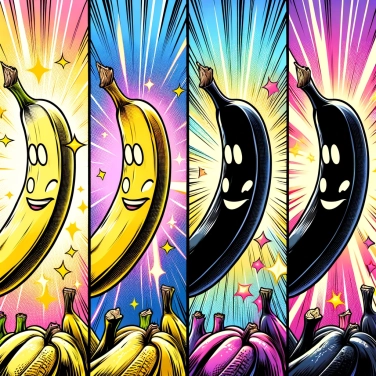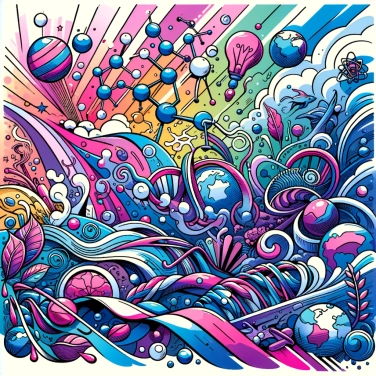Bananas turn black as they age due to the reaction of the enzyme polyphenol oxidase with the oxygen in the air. This reaction oxidizes the phenolic compounds present in the banana, forming brown and black pigments.

When a banana ripens, its cells begin to break down slowly. Gradually, an enzyme called polyphenol oxidase (PPO) comes into contact with certain compounds called polyphenols. This encounter triggers their oxidation, a chemical reaction where they react with the oxygen present in the air. And there you have it, the famous dark color appears. This darkening is simply due to the formation of colored substances called melanins, the same pigments that can be found in human skin or hair. The older the banana gets, the faster this process accelerates, and the black coloration gradually spreads to the entire skin of the fruit.
Ethylene is a gaseous plant hormone that triggers and accelerates the ripening of fruits, particularly bananas. The more a banana ripens, the more it releases ethylene, causing nearby bananas to ripen quickly as well, like a sort of domino effect. Specifically, ethylene stimulates the conversion of starches into sugar, making the banana sweeter, but also weakens the cell walls. As a result, the tissues begin to degrade, leading to the appearance of dark and then black spots on the skin. That's why when storing bananas near other ethylene-producing fruits like apples, they age even more quickly.
Temperature is a key factor: high heat speeds up the aging of bananas by increasing the rate of internal chemical reactions. A banana placed in a warm environment will quickly turn black, while one kept in a cool place will slow its darkening, but may also develop a dark skin due to intense and prolonged cold. Humidity can also play a secondary role: a very humid environment promotes the rapid appearance of brown and then black spots by facilitating the multiplication of microorganisms. Finally, physical shocks such as repeated bumps or mechanical pressure on the skin will crush the outer cells, cause rapid oxidation, and lead to black marks appearing sooner than expected.
The black spots that appear on aging bananas are caused by pigments called melanins. These melanins result from chemical reactions involving the activity of specific enzymes such as polyphenol oxidase. As it ages or gets damaged, the banana peel begins to produce these black pigments to protect and repair the damaged or stressed parts. These pigments serve an interesting defense function by protecting the fruit from microbial infections and parasites, creating a natural barrier. The riper or more damaged the banana is, the more this production of melanin intensifies, which is why very ripe fruits can sometimes appear almost completely black.
Blackened bananas can be advantageously used in cooking: they are excellent for recipes such as pastries, smoothies, or muffins, thanks to their soft texture and pronounced sweet flavor.
If you want to slow down the browning of bananas, simply wrap each one individually by the stem using plastic wrap or aluminum foil: this trick limits the release of ethylene and extends their freshness.
The black spots on banana skin indicate not only their ripening but also an increase in their content of health-beneficial antioxidants.
In the past, fiber from the banana plant was commonly used in Asia to make traditional paper, textiles, and even durable ropes.
To slow down the browning, you can place your bananas in the refrigerator or wrap their stem (top end) with plastic wrap. This helps limit the release of ethylene, thereby reducing their ripening speed.
It's primarily due to ethylene, a gas naturally produced by certain fruits, including apples, pears, and tomatoes. Ethylene acts as a plant hormone that stimulates ripening. Therefore, when near other ethylene-producing fruits, bananas ripen and turn black more quickly.
Yes, very low temperatures accelerate the degradation of the cell membranes in bananas, leading to rapid browning and deterioration of their texture. It is recommended to store bananas between 13 and 15°C to optimize their shelf life.
No, they are not less nutritious. In fact, as they ripen, bananas become richer in antioxidants. They also contain a slightly increased concentration of natural sugars, which gives them a sweeter taste.
No, a black banana is generally safe to eat as long as it doesn't show any obvious signs of mold, rot, or a strong unpleasant odor. In fact, the riper the banana, the sweeter and easier to digest it becomes, making it ideal for recipes such as banana bread.

No one has answered this quiz yet, be the first!' :-)
Question 1/5